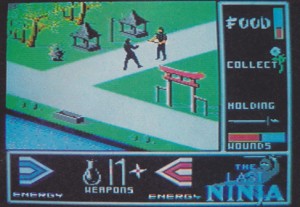
A controversial entry originally, but which was eventually the result of a development which became too difficult for the original team to complete. Hugh Riley and Mark Cale shed light on the original Last Ninja and what happened….
Casting things back, it was claimed some years ago that Last Ninja was originally a game by an Hungarian team, which was to have System 3 as the publisher. The rumor was that the team had sent System 3 an almost complete version for testing, and System 3 finished it off and published it.
Further to this, another Hungarian told the story of how he spoke to a mathematician who claimed to be part of the original LN development crew. The mathematician backed up his claim by demonstrating the Level editor system used to place trees and other objects into the game.
The contributor (who wanted to remain nameless) went on to say…
“I couldn’t believe my eyes! He told me, that for example Shogun on the last level moves so “dizzy”, because they couldn’t finish it. They sent the program out for testing (or checking to Germany or England I’m not quiet sure), and they stole the whole program, after they finished quickly and released before the Hungarian group finished the same.
If it’s true, than what a scandal! He told me, that originally you didn’t have to throw a gas bomb under the dragon’s nose – the only thing you had to to is to avoid its flames (and that’s right I downloaded the LN preview). He told me moreover, that originally you could kill the spider in the dungeons by jumping onto his “back”. That remained just a plan. He also told me the date of the programming works. Unfortunately I forgot it, but, I think from August 1986 to March or April 1987.”
Was any of this true? Well, it was declared as complete rubbish.
The story developed and became clearer a few years ago as Kai Spitzley, webmaster of the excellent Last Ninja archives, shared findings, including the following from Hugh Riley (Graphics artist for LN1 and 2)…
“When I came onto Ninja 1 it was being programmed for System 3 by a subsidiary of Andromeda in Hungary (Caesar the Cat? now there’s going back!).
Bob Stevenson had done some mock up screens for the adverts then left. I spent 3 weekends in Budapest (still behind the iron curtain) where it became apparent that their programmers were having difficulties.
They were programming in forth (used for washing machines) so back in London John Twiddy was brought in to rewrite the code and we worked together in Mark Cale’s (Mr System 3) front room and various other places. By the time we finished Twiddy reckoned there was only one byte left in the machine which explains the crappy ending.”
GTW also got in touch with one of the original developers of Last Ninja, Istvan Bodnari, who confirmed the level editor, but didn’t know its existence now. Nothing was mentioned about the game being stolen though, so we believe that nothing bad actually happened. He even confirmed that the graphics were all supplied by System 3, so it confirms Andromedia were developing the game FOR System 3, and it was not a game that System 3 were trying to purchase from them.
Although we now had both Hugh and Istvan confirming the real story, Mark Cale also came in to set the record straight as well in November 2015:
“I wanted to put a close to the idea that Hungarian team wrote and finished 85% another Last Ninja. Hugh Riley will tell you they tried and failed. Currently we are making a number of videos from people we have worked with including Andromeda about all our games.
Andromeda’s Robert Stein will state on video that he refunded all the advances we gave on Last Ninja as they failed to even get a ninja sprite Hugh drew to animate let alone fight. The only game ever finished by them was IK on the Atari ST and that was only after I sent both Archer Maclean and Bob Stevenson to Budapest.
Hugh and I did 3 trips to Hungary and gave up on Last Ninja when we found out they were writing the game in Forth which is almost as slow as basic. The screen shot you showed was the original Bob Stevenson concept shot which we had published in magazines like C&VG announcing the game. I’m sure Hugh, Archer and Bob can all tell you their thoughts on the quality of game programming at the time.”
Frustratingly there was no Ninja character to move or fight with other characters!
So there we have it. We’re unsure how some of the original stories came to fruition, but it is a chapter that can sort of be closed. The video itself surfaced a few years ago at: https://www.youtube.com/watch?v=nOzcDPCNd_I for you to check out (in Hungarian). Regardless of the controversies there could well be another version of Last Ninja out there, and we would love to find this early version. But it sounds like essentially it would just be a broken version of the game we all know and love, with the same graphics and maps that Hugh had done. It would be only interesting from a historical point of view.
The large screenshot with rather different looking background elements and a score panel which is vastly different in the gallery was confirmed to be an original concept screenshot. This was drawn by Bob Stevenson and was published in magazines like CVG announcing the game. When Bob left the project, Hugh took over and re-did some of the panels and graphics, but essentially the end result was fairly similar.
Interestingly, in the sleeve of International Karate, along with Last Ninja – two other further titles are announced for 1986 in the form of Last Ninja: Return of the Last Ninja and Revenge of the Last Ninja. Martin/Stadium64 wonders if the two parts would have just been some of the later levels split into a sequel of some kind. They didn’t get far anyway, possibly after the first game got delayed like it did.
Recently in 2021, we have added the Zzap Sampler tape and various demos disk (thanks to The Last Ninja archives) to the downloads, as it contains a non-playable preview of The Last Ninja that features a number of sprites and backgrounds which never featured in the final game. There is also a slightly different game panel too. Marcin ‘Tenchi’ Świętoniewski kindly provided versions where the panel had no corruption.
I wondered if there is any way of making the demo playable, so other screens could be uncovered. Well, in 2022, Luigi Di Fraia confirmed that only the 4 locations shown were present, after decoding the integrator file for the demo.
A massive thanks to Jazzcat, Mark Cale and Hugh Riley for finally clearing up the story behind the game!
Contributions: Levi Buttas (WoLaNd/T38), Kai Spitzley, Adam, Fabrizio Bartoloni, Hugh Riley, Mark Cale, Jazzcat, Martin/Stadium64, SjoCi, Luigi Di Fraia, Marcin 'Tenchi' Świętoniewski
Supporting content
Available downloads
- Preview_LNV1 (zip)
Gallery
Creator speaks
Istvan Bodnari talks about work on Last Ninja V1…
“Indeed, we did work on the game, but then the team had all sorts of difficulties, as a result we stopped writing computer games. I did ask a friend who was also involved, but he could not give too much specifics to my memories. ”
1) Do you have any other names for the developers?
“Most of the members of our studio came from a secondary school specialised in maths, some of us went on and studied maths at university (not myself).”
2) The maths teacher suggested you had a tool called the “Integrator”, which the levels were created with. Can you tell us anything about this level creator?
“Not much. We had two systems side by side. One, if I recall correctly, a SAGE system, which generated code under C+ (or C++?), and as that did not generate
efficient code for some purposes, we wrote the Forth system of our own, which could generate code from subroutines written in Forth.”
3) Is there any chance that the “Integrator” (or anything of the old version) survived today?
“I doubt this.”
4) There was a rumor that the UK company that released the game, never paid Andromeda for their hard work. This sounds a bit of a harsh claim, is any of it true?
“I don’t think we were part of the Andromeda unit, but that is again too long ago to remember.”
5) Did Andromeda develop/design Last Ninja from scratch themselves, and System 3 purchase the game from you when you hit troubles with the game?
“No idea.”
6) Rumour has it that the original game was programmed in Forth – is this true?
“See above.”
7) Is the final released game (http://www.lemon64.com/games/details.php?ID=1488 ) much different from the game you worked on?
“These screens are the same as the ones we worked with – which is only to be expected, as they were supplied by the UK company.”
Related articles
The following is a quick summary of the video at https://www.youtube.com/watch?
The Hungarian team was mostly made of mathematicians. The contract was to develop two games for multiple platforms.
“That time what was very unique is that there is a group of programmers in Hungary, then generally the developers in the UK were individual programmers working from their bedrooms, programming games. So it wasn’t a professional setup with studios and… you know this was the first time that we met with some development teams […] and the two games we started of with was Bangkok Knights and Last Ninja.” Mark Cale
One of the problems where the cultural differences of the 1986 west and east. As the back then lead programmer Ferenc Ruzsa explained:
“No one heard the word ‘ninja’ before, if there is some Japanese thing: ‘you mean judo?’ This is how much the ordinary man understood about this, even so we were not really ordinary people, because we were mathematicians…”
“(I heard it first in my life) the word ‘nunchaku’, then I learned (what that is)” IstvÁ¡n BodnÁ¡r, ex-developer
So they started the whole thing with getting some ninja movies and then watching it together.
The original contract wanted to ship the game by Christmas on multiple platforms. The teams specialty was that they wrote their games in machine language directly, but the close deadline made it clear they can’t do this with their usual approach. So they came up with the solution that they will code the game only once in a single language and write their own compiler (code translator to machine code) for each hardware, this way they only need to code the game once and the outcome will be still fast. They choose the Forth language as the syntax, so they don’t need make a new language from zero and can start a game programming immediately while another part of the team can work parallel on the compiler.
“That was a kind of development philosophy that would end up being the future.” Bob Stevenson
“They worked out a system which was revolutionary, which was to try and build blocks, high-res blocks together making high-res screens. So at that stage what we were able to try and do potentially was to make ground-breaking graphics with this new concept of building high resolution blocks and the Integrator was born.” Mark Cale
“The hardest part was the implementation of the background-drawer, we called it the Integrator.” ZoltÁ¡n ÁdÁ¡m, ex-developer
The Integrator is in fact the level editor and drawer of the game. So saying that that the Hungarian team did nothing or that their work was not present in the final product would be wrong. BUT at the same time they themselves admit that they did not had a working game and they had problems:
“Where we were (with the development) there were game mechanic fragments… And one could imagine how all this will fit together, but… WHEN will it fit together? That no one could imagine. […] When you have passed the first deadline, then the second, then the third, then the thing looks a bit bad. […] The contract was to release to multiple platforms at the same time, but the Commodore version was the best at the time. […] We looked at this project as: ‘we did not made a forth compiler as a joke, if I wanted to make this on the Commodore then I will do this on the Commodore and write the whole thing in machine code.” IstvÁ¡n BodnÁ¡r
So after many missed deadlines the System 3 pulled the plug on the Hungarian team:
“They didn’t understand playability and to try to translate how something should play, it was quite often lost at translation. So on both of these projects we moved on from… […] There is no actual code in the program that was done by the Hungarian team. […] They were technically very very good and for sure without coming up the theory with the Integrator the Last Ninja could not happen, because once we had the toolset, which was built in Hungary, to base how we will create the graphics with Hugh Riley… that game would never have happened, so you know without the help of Robert and his team (the Hungarian team) that wouldn’t have happened.” Mark Cale
Personal opinion from SjoCi:
I didn’t here from any of the interviewed Hungarian developers that they thing game was stolen from them. There is a kind of sourness in their voice, but it is directly pointed at the fact if contract where only to make the Last Ninja on the Commodore they would have done it by the original deadline, but they admit that was not the case. They agreed to something else and they ended up with more than they could handle in the given time.
So was the game really stolen? I don’t really think so… But was the Hungarian team’s work essential in the final product? Absolutely.
I am Hungarian and therefor I’m biased. I’m damn proud of the Hungarian team and their achievements. But I also understand System 3’s decision (the part about the Forth language is I think a major misunderstanding, but crossing many deadlines… no playable character on screen… yeah, that’s more than reason to pull the plug).
Update history
- 05/03/24 – Updated download link with fixed and tidied up version of previews thanks to Marcin ‘Tenchi’ Świętoniewski
- 03/04/22 – Updated about the demo not featuring anything more than its 4 screens.
- 12/04/21 – Added Zzap Sampler tape to downloads with early preview.
- 09/10/20 – Link to video added and extra translation added to “Articles” thanks to SjoCi
- 06/11/15 – Real story told, details from Mark Cale added
- 24/10/14 – Old screens added thanks to Fabrizio and http://heechee.net/c64/ninja/art_rare.php


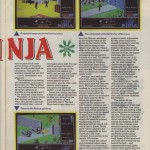
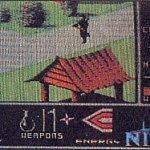
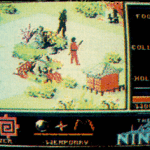
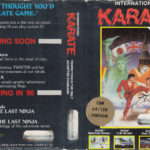

> I wonder if there is any way of making the demo playable, so other screens could be uncovered?
I decoded the Integrator file for the demo and I can only see 4 locations: the ones that are visible in the demo itself. So, unfortunately, there don’t seem to be any other one to uncover.
Thank you very much for confirming Luigi – i’ll update the page accordingly.
What ever happened to the the Atari 800 version that was promised in the adverts.
Hi Dan, basically they couldn’t find someone to do the conversion and then began to lose faith in the platform early on, so it was scrapped. Mark suggests that nothing was ever started in the end. Harlequin Software did attempt to convert the sequel years later to the platform, but sadly didn’t manage it either.
There is this new docu titled Moleman 4 – Longplay which recounts the so far little-known story of the beginnings of video game development behind the Iron Curtain.
It has a 10 mins part on the Last Ninja development in Hungary.
I think it can answer any questions about the Hungarian developers.
They were not students but most of them had degrees in mathematics research.
They developed their own language to be able to deliver the game on different platforms at once. They had some of the levels done, but they missed all the deadlines.
Watch the docu if you are interested in this story:
(NOTE: VIDEO NO LONGER AVAILABLE: vimeo via /ondemand/moleman4)
A quick summary on the video (which is available here: https://www.youtube.com/watch?v=nOzcDPCNd_I ) :
The hungarian team was mostly made of mathematicians. The contract was to develop two games for multiple platforms.
“FRANK – Moved SjoCi’s excellent help and translation notes to “Articles” tab in main write up.”
Thanks SjoCi, that was brilliant and thanks for letting me know about the video.
I’ve cut your comment and moved to “Articles” to share as part of the main piece, with a credit to yourself. I agree with you completely, and it is good to have things cleared up.
You familar with the interview with Mark Cale, way back in Retrogamer issue 18?
Mark stated the entire vision of The Last Ninja was his, entire idea of an isometric viewpoint etc and goes onto say he was very ‘hands-on’ and ALL content went through him.
He does debunk claims Ben Daglish was offered a Mercedes as payment for his music, instead of cash and Mark goes onto say a lot of people lived in the past and came up with a lot of stories regarding development of TLN…and said it was a shame people had to go around and spread rumours, stories and bullshit….
Reading it now i wonder if he was thinking of claims made relating to the Hungarian team?.
There is much controversy around the conception of the game still today, and the topic still gets re-visited. More than anything, it was a lack of a fair professional and business partnership between the parties. Check out this chunk from a new documentary:
(UPDATE: Video no longer available: via vimeo at /148275039)
There are two further screenshots here: http://heechee.net/c64/ninja/art_rare.php
Thanks Fabrizio, adding now! :)
Regular Zzap64 readers might recal the Atari 800/130 Xl/XE versions being promised as ‘coming soon’. I have since since seen a readers letter saying they wrote to System 3 around the time Last Ninja 2 and Myth had been released on C64 and asking of chances of either appearing on A8, System 3 replied they were hopeful conversion work on Last Ninja would ‘start soon’.Dunno if this is of interest?.
Whatever…
a) that link is faulty: “Here is a large screenshot of the game with rather different…”
b) Do I get this right and is the name Andromedia intentioned or a typo/misunderstanding from Andromeda?
c) Forth ain’t that bad. ;)
greets, Adam
Thanks Adam, i’ll fix the mistype and also refer to the gallery for the image. Contribution credit added :)